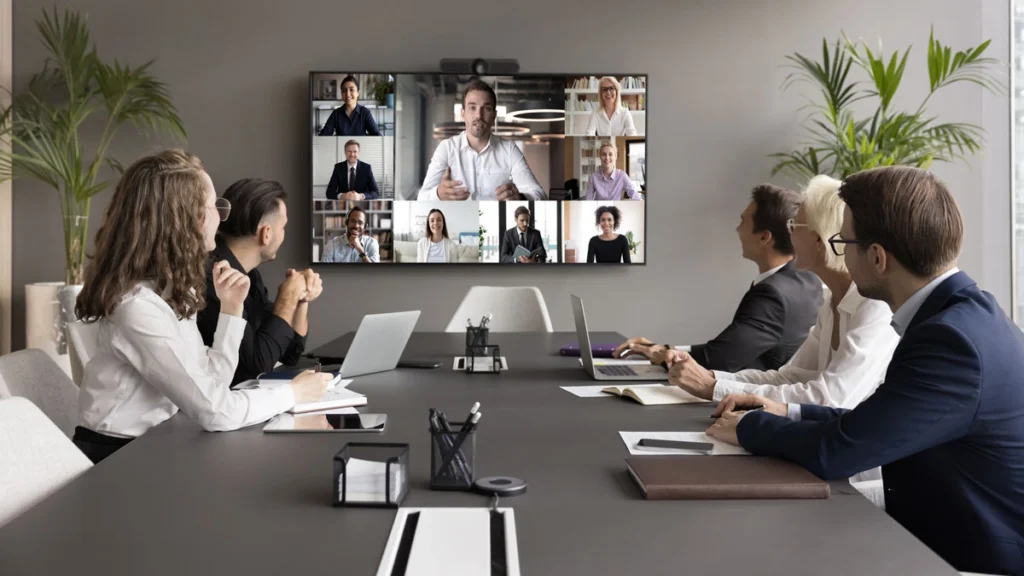The workplace is evolving rapidly, and hybrid meeting spaces have become a key component in adapting to the new normal. By 2025, the integration of in-person and remote team members, advanced video conferencing tools, and collaborative AV solutions will redefine how we connect and collaborate. Here’s why hybrid meeting spaces are the future and how they’re shaping the workplace.

1. Seamlessly Blending In-Person and Remote Participants
Hybrid meeting spaces are designed to create equitable experiences for both in-person and remote attendees, ensuring everyone feels included and engaged.
Key Developments:
- Immersive Video Conferencing: High-definition cameras and AI-driven framing ensure remote participants are seen clearly and feel part of the room.
- Advanced Audio Systems: Noise-canceling microphones and spatial audio create a natural sound experience, making conversations fluid and lifelike.
- Unified Communication Platforms: Tools like Microsoft Teams and Zoom integrate seamlessly with AV systems, streamlining interactions across locations.
Why It Matters: Inclusive meeting spaces foster better collaboration, reduce miscommunication, and ensure all voices are heard, regardless of location.
2. Collaborative AV Solutions
AV technology is at the heart of hybrid meeting spaces, enabling teams to work together effectively, whether they’re across the table or across the globe.
Innovations to Watch:
- Interactive Displays: Digital whiteboards allow participants to brainstorm and share ideas in real-time, with instant access for remote users.
- Screen Sharing and Co-Editing: Multiple users can share screens or co-edit documents simultaneously, promoting real-time collaboration.
- Gesture and Voice Controls: Touchless interfaces powered by AI make controlling AV equipment more intuitive and hygienic.
Why It Matters: These tools create dynamic environments where creativity and productivity can thrive, regardless of physical boundaries.
3. Automation and AI-Enhanced Experiences
AI and automation are revolutionizing hybrid meeting spaces, making meetings smarter, faster, and more effective.
Key Features:
- Automated Room Setup: Systems adjust lighting, temperature, and AV configurations before meetings begin, based on scheduled preferences.
- Meeting Transcriptions: AI-powered tools provide real-time captions and post-meeting summaries, ensuring nothing is missed.
- Facial Recognition: Personalized settings activate as participants enter the room, tailoring the experience to their preferences.
Why It Matters: Automation reduces setup time and allows teams to focus on what truly matters: collaboration and decision-making.
4. Enhanced Flexibility and Scalability
Hybrid meeting spaces are designed to adapt to various team sizes, locations, and purposes, making them a versatile solution for businesses.
Flexible Solutions:
- Modular Furniture and Equipment: Easily reconfigure spaces to accommodate different meeting formats, from small huddles to large presentations.
- Portable AV Systems: Mobile units with integrated displays and cameras bring professional-grade tools to any location.
- Cloud-Based Solutions: Centralized management systems ensure seamless updates and remote troubleshooting.
Why It Matters: Scalable solutions ensure businesses can respond to changing needs without costly overhauls.
5. Prioritizing Sustainability and Well-Being
Modern meeting spaces are not only functional but also designed with sustainability and employee well-being in mind.
Green and Healthy Design:
- Energy-Efficient Technology: AV systems with low power consumption and auto-shutdown features reduce environmental impact.
- Ergonomic Layouts: Furniture and room designs promote comfort and reduce fatigue during long meetings.
- Biophilic Elements: Incorporating natural light, plants, and calming colors fosters a healthier, more inviting atmosphere.
Why It Matters: By prioritizing sustainability and well-being, companies can enhance employee satisfaction and demonstrate corporate responsibility.
Preparing for the Hybrid Future
To thrive in 2025, businesses should:
- Invest in Cutting-Edge Technology: Choose AV systems and tools that integrate seamlessly and support remote collaboration.
- Train Teams: Equip employees with the skills to use hybrid meeting technologies effectively.
- Focus on Inclusivity: Design spaces and systems that cater to diverse needs and preferences.
Hybrid meeting spaces are not just a trend—they’re a strategic investment in the future of work. By embracing these innovations, businesses can create environments where teams collaborate effectively, innovate boldly, and achieve more together.



